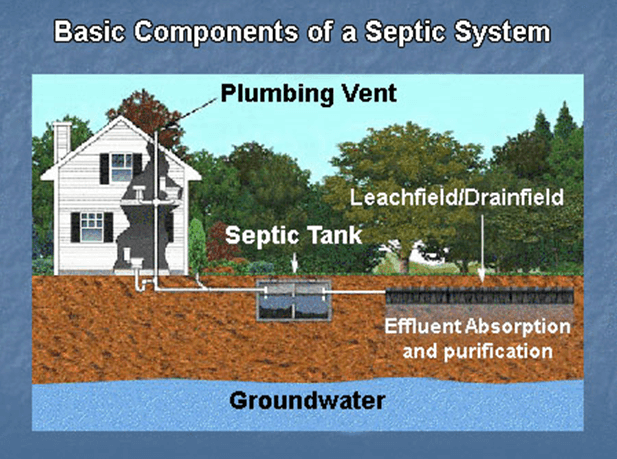Toilet Paper (TP) test video
Recommended TP: Scotts single ply and Angel Soft

|
The basic septic tank is made up of two compartments. Inlet side is the inlet (ingress) from the house. The
second compartment normally holds the effluent liquid. The inlet is the source of the black water, gray water and solids entering the tank. In the first compartment inlet side you will find 3 layers. First layer at the bottom of the tank is your sludge. Next layer is the liquid and lastly at the top is the scum layer. The second compartment will hold some sludge at the bottom of the tank and minimal scum layer. If you find the second compartment containing excessive sludge and/or scum it is time to clean the tank. The second compartment is normally the last destination for the effluent before going to the leach field. Within the second compartment you should have an effluent filter. If no filter is present this is a great warranty to have to prevent clogging of your drain field. The leach field has various names including:
Additional Septic System Details: Septic systems are individual wastewater treatment systems that use the soil to treat small wastewater flows, usually from individual homes. They are typically used in rural or large lot settings where centralized wastewater treatment is impractical. There are many types of septic systems in use today. While all septic systems are individually designed for each site, most septic systems are based on the same principles. A septic system consists of a septic tank, a distribution box, and a drainfield, all connected by pipes called conveyance lines. Your septic system treats household wastwater by temporarily holding it in the septic tank where heavy solids and lighter scum are allowed to separate from wastewater. The solids stored in the tank are decomposed by bacteria and later removed, along with the lighter scum, by a professional licensed septic tank pumper. After the partially treated wastewater leaves the tank, the wastewater in a non-HighLevel treatment system will flow to a drain field. The drain field consists of pipes with drainage holes on the sides to allow the wastewater to drain into gravel. This effluent then slowly seeps into the subsurface soil where it is further treated and purified. Slow draining tubs and toilet back-ups are signs of septic systems failure. Standing discolored wastewater in the drain field area may indicate a failing system. We can evaluate your system, including inlet and outlet T's, distribution boxes and the drain field. A simple evaluation can save your family thousands of dollars, unforeseen stress and embarrassment. Do:
Don't:
Helpful Links: EPA Homeowner PDF Guide CPOW - Homeowner Information regarding septic system / Onsite Wastewater Treatment Systems (OWTS): http://www.cpow.net/resources/general-information/ |
Copyright © 2016-2025 Search Septic, LLC. All rights reserved. Search Septic Proprietary.

